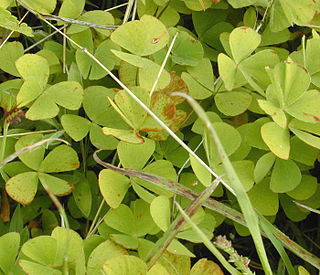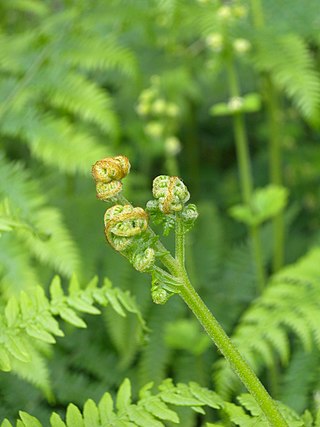
The order Salviniales is an order of ferns in the class Polypodiopsida.

Gleicheniales is an order of ferns in the subclass Polypodiidae. The Gleicheniales have records potentially as early as the Carboniferous, but the oldest unambiguous records date to the Permian.

The Dryopteridaceae are a family of leptosporangiate ferns in the order Polypodiales. They are known colloquially as the wood ferns. In the Pteridophyte Phylogeny Group classification of 2016 (PPG I), the family is placed in the suborder Polypodiineae. Alternatively, it may be treated as the subfamily Dryopteridoideae of a very broadly defined family Polypodiaceae sensu lato.

A pteridophyte is a vascular plant that disperses spores. Because pteridophytes produce neither flowers nor seeds, they are sometimes referred to as "cryptogams", meaning that their means of reproduction is hidden.

Polypodiaceae is a family of ferns. In the Pteridophyte Phylogeny Group classification of 2016, the family includes around 65 genera and an estimated 1,650 species and is placed in the order Polypodiales, suborder Polypodiineae. A broader circumscription has also been used, in which the family includes other families kept separate in PPG I. Nearly all species are epiphytes, but some are terrestrial.

Blechnaceae is a family of ferns in the order Polypodiales, with a cosmopolitan distribution. Its status as a family and the number of genera included have both varied considerably. In the Pteridophyte Phylogeny Group classification of 2016, the family has 24 genera, and excludes genera placed in the separate family Onocleaceae. The family is divided into three subfamilies, including Blechnoideae s.s. Alternatively, the entire family may be treated as the subfamily Blechnoideae s.l. of a very broadly defined family Aspleniaceae, and include genera others place in Onocleaceae.

Pteridaceae is a family of ferns in the order Polypodiales, including some 1150 known species in ca 45 genera, divided over five subfamilies. The family includes four groups of genera that are sometimes recognized as separate families: the adiantoid, cheilanthoid, pteridoid, and hemionitidoid ferns. Relationships among these groups remain unclear, and although some recent genetic analyses of the Pteridales suggest that neither the family Pteridaceae nor the major groups within it are all monophyletic, as yet these analyses are insufficiently comprehensive and robust to provide good support for a revision of the order at the family level.

The Athyriaceae are a family of terrestrial ferns in the order Polypodiales. In the Pteridophyte Phylogeny Group classification of 2016 (PPG I), the family is placed in the suborder Aspleniineae, and includes two genera. Alternatively, it may be treated as the subfamily Athyrioideae of a very broadly defined family Aspleniaceae. The family has with a cosmopolitan distribution.

Onocleaceae is a small family of terrestrial ferns in the order Polypodiales. It is placed in the suborder Aspleniineae in the Pteridophyte Phylogeny Group classification of 2016. Alternatively, the family, along with Blechnaceae, may be placed in a very broadly defined family Aspleniaceae as the subfamily Blechnoideae. The family may contain from one to four genera, consisting of five species largely in north temperate climes. The four genera, Matteuccia, Onoclea, Onocleopsis and Pentarhizidium, may be included under the single genus Onoclea.

The Polypodiidae, commonly called leptosporangiate ferns, formerly Leptosporangiatae, are one of four subclasses of ferns, the largest of these being the largest group of living ferns, including some 11,000 species worldwide. The group has also been treated as the class Pteridopsida or Polypodiopsida, although other classifications assign them a different rank. Older names for the group include Filicidae and Filicales, although at least the "water ferns" were then treated separately.

Aspleniineae is a suborder of ferns in the order Polypodiales. It is equivalent to the clade eupolypods II in earlier systems; it is also treated as a single very broadly defined family Aspleniaceae. The suborder generally corresponds with the order Blechnales as described by J. L. Reveal in 1993. Aspleniineae includes some important ferns, including Onoclea sensibilis, the sensitive fern, which grows as a virtual weed throughout much of its temperate North American range, and ferns of the genus Thelypteris, a genus that has shown remarkable speciation. It also includes one of the more common horticultural ferns, Matteuccia struthiopteris, the ostrich fern.

Saccolomataceae is a family of ferns in the order Polypodiales with about 19 species. It has been formerly treated as part of the Dennstaedtiaceae, however it has been classified as its own family according to Smith et al. (2006) The genus Saccoloma has been classified to include Orthiopteris, but the phylogeny of the group not yet fully understood. The family includes a dozen known species.

Cystopteridaceae is a family of ferns in the order Polypodiales. In the Pteridophyte Phylogeny Group classification of 2016 (PPG I), the family is placed in the suborder Aspleniineae of the order Polypodiales, and includes three genera. Alternatively, it may be treated as the subfamily Cystopteridoideae of a very broadly defined family Aspleniaceae.

Hypodematiaceae is a family of ferns in the order Polypodiales. In the Pteridophyte Phylogeny Group classification of 2016 (PPG I), the family is placed in the suborder Polypodiineae. Alternatively, it may be treated as the subfamily Hypodematioideae of a very broadly defined family Polypodiaceae sensu lato. The family consists of two, or in some versions three, small genera.

Tectariaceae is a family of leptosporangiate ferns in the order Polypodiales. In the Pteridophyte Phylogeny Group classification of 2016 (PPG I), the family is placed in the suborder Polypodiineae. Alternatively, it may be treated as the subfamily Tectarioideae of a very broadly defined family Polypodiaceae sensu lato. The family comprises seven genera, of which Tectaria is by far the largest.

Polypodioideae is a subfamily belonging to the fern family Polypodiaceae, which is a member of the suborder Polypodiineae in the Pteridophyte Phylogeny Group classification of 2016 (PPG I). Alternatively, the subfamily may be treated as the tribe Polypodieae within a very broadly defined family Polypodiaceae sensu lato.

Polypodiineae is a suborder of ferns in the order Polypodiales. It is equivalent to the clade eupolypods I in earlier systems, and to the very broadly defined family Polypodiaceae in the classification of Christenhusz & Chase (2014). It probably diverged from the suborder Aspleniineae during the mid-Cretaceous. The divergence is supported by both molecular data and an often overlooked morphological characteristic which lies in the vasculature of the petiole. Most species that make up the suborder have three vascular bundles. The only exceptions are the grammitid ferns which have one, and the genus Hypodematium which has two. This differs from eupolypods II which mostly have two vascular bundles.

Diplaziopsidaceae is a family of ferns in the order Polypodiales. In the Pteridophyte Phylogeny Group classification of 2016 (PPG I), the family is placed in the suborder Aspleniineae, and includes two genera. Alternatively, it may be treated as the subfamily Diplaziopsidoideae of a very broadly defined family Aspleniaceae.
Rhachidosorus is a genus of ferns in the order Polypodiales. It is the only genus in the family Rhachidosoraceae in the Pteridophyte Phylogeny Group classification of 2016. Alternatively, the genus may be placed in the subfamily Rhachidosoroideae of a more broadly defined family Aspleniaceae, the family placement used in Plants of the World Online as of November 2019.

















